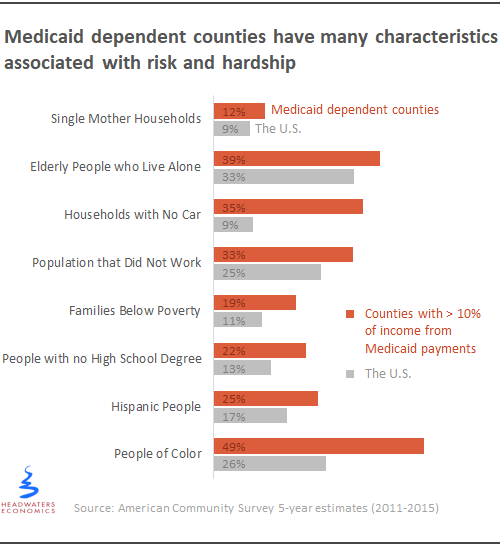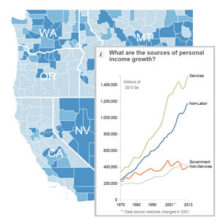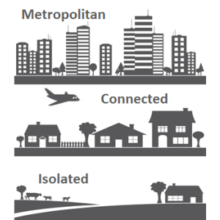Much of the recent health care debate in Congress focused on potential cuts to Medicaid, the federal program that benefits roughly 70 million elderly, young, disabled, or poorer Americans.
A Headwaters Economics analysis shows that Medicaid payments contributed more than 10 percent of total personal income in five percent of counties in the United States (163 counties) in 2015. Often these counties already are experiencing a wide range of hardship and risk.
Source: Bureau of Economic Analysis, Regional Economic Accounts, 2015
Counties Reliant on Medicaid Also Experiencing a Wide Range of Hardship and Risk
When compared to the U.S., the 163 Medicaid-dependent counties, on average, have more minorities, are less educated, and are poorer than the country as a whole.
Among these Medicaid-dependent counties, seven counties derived more than 20 percent of personal income from Medicaid: Apache County, Arizona and six Kentucky counties: Breathitt, Clay, McCreary, Magoffin, Owsley, and Wolfe. Apache County contains parts of both Navajo and Apache Indian Reservations and is approximately three-quarters American Indian. The six Kentucky counties are historically coal mining communities that have experienced sharp declines in coal-related jobs since the early 1980s.
A “Populations at Risk” profile of the Medicaid-dependent counties shows that they rank higher in single-mother households, elderly individuals who live alone, households with no car, and several other factors that are associated with adverse social, health, and economic outcomes.
Medicaid-dependent counties also tend to have high reliance on other forms of hardship-related payments that are part of what economists call non-labor income.
Non-labor income sources such as investments, Social Security, Medicare, and Medicaid are the largest and fastest growing sources of personal income for many counties. Rural counties especially are dependent on non-labor income.
Explore our broader research on non-labor income, which includes Medicaid, to better understand your own county or the widespread impacts of policy decisions being considered in Congress.





